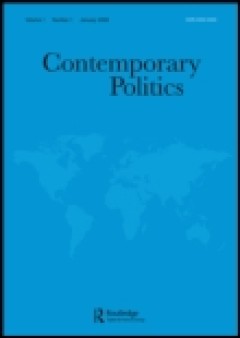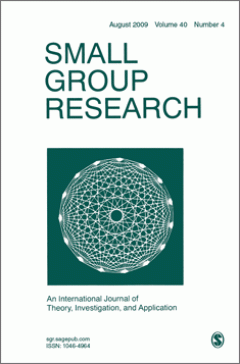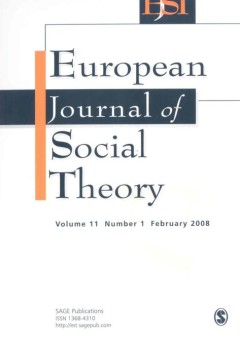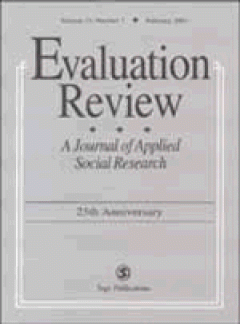Filter by

Virtual Government–Citizen Relations: Informational, Transactional, or Coll…
Public administration theory and practice suggest that e-government, citizen participation, and government�citizen collaboration are contributing to a movement toward New Public Service�as opposed to Old Public Administration and New Public Management. We explore this by focusing on the relationship between the Washington, D.C., police and local residents via online discussion groups. We ask, H…
- Edition
- Vol. 42 no. 7. November 2010.pp. 836-858
- ISBN/ISSN
- 00953997
- Collation
- -
- Series Title
- Administration & Society
- Call Number
- -

Into the Woods: A Cautionary Tale for Governance
In 2010, the state is not merely hollow but increasingly empty, and those of us in government have to find their energy and purpose in the process of rebuilding it. Our happy endings�the specific outcomes we claim to want�somehow come along with unexpected twists and losses. We�ve discovered that life and governance aren�t linear and predictable. In the 20th century, public administration (PA) …
- Edition
- Vol. 42 no. 7. November 2010.pp. 859-883
- ISBN/ISSN
- 00953997
- Collation
- -
- Series Title
- Administration & Society
- Call Number
- -

Immigration and integration policy and the Austrian radical right in office: …
This article focuses on the radical right's influence on immigration and migrant integration policy by scrutinising the 6-year period in national government of the Austrian Freedom Party and Alliance for Austria's Future. Specifically, it investigates the radical right's influence on migration control, migrant integration, citizenship and asylum policy. While previous studies have often credite…
- Edition
- Volume 16, Issue 4 December 2010 , pages 337 - 354
- ISBN/ISSN
- 13569775
- Collation
- -
- Series Title
- Contemporary Politics
- Call Number
- -

Problems of political transition in Ukraine: leadership failure and democrati…
Democratisation and consolidation of a political system encompass a range of complex challenges, for which effective leadership is pivotal. However, the skills that a leader requires to break through and introduce change are not necessarily the same as those needed to maintain stability. This article examines the case of Viktor Yushchenko as president of Ukraine following the Orange Revolution.…
- Edition
- Volume 16, Issue 4 December 2010 , pages 355 - 367
- ISBN/ISSN
- 13569775
- Collation
- -
- Series Title
- Contemporary Politics
- Call Number
- -

Crafting democratic control of the military in South Korea and the Philippine…
This article explores how a military's organizational character (cohesion or lack thereof) shapes military officers' attitudes toward new civilian leadership in democratizing South Korea and the Philippines. It suggests that a factionalized military makes civilian control much more difficult and the route to democratic consolidation highly unstable and incomplete for three reasons. First, in th…
- Edition
- Volume 16, Issue 4 December 2010 , pages 369 - 382
- ISBN/ISSN
- 13569775
- Collation
- -
- Series Title
- Contemporary Politics
- Call Number
- -

Myanmar: analyzing problems of transition and intervention
Myanmar's State Peace and Development Council touts the 2010 elections as an important milestone on the roadmap to democracy. While the consensus among scholars is that the result is a foregone conclusion, these elections may also mark the beginning of a transition. As a transition from authoritarian rule may lead to internal chaos and result in calls for external intervention, the relevant dim…
- Edition
- Volume 16, Issue 4 December 2010, pages 383 - 401
- ISBN/ISSN
- 13569775
- Collation
- -
- Series Title
- Contemporary Politics
- Call Number
- -

State crimes against democracy in the war on terror: applying the Nuremberg p…
This article asks whether, in waging war in the Middle East, the Bush-Cheney Administration developed and executed a conspiracy comparable to the one for which Nazi leaders were tried, convicted, and executed at Nuremberg after World War II. To meet the Nuremberg standards, such a conspiracy must include efforts to subvert the constitutional order. Today, scholars refer to these actions as 'sta…
- Edition
- Volume 16, Issue 4 December 2010 , pages 403 - 420
- ISBN/ISSN
- 13569775
- Collation
- -
- Series Title
- Contemporary Politics
- Call Number
- -

International financial governance in hard times: tracing the transformations
This article reviews the tenets of the intellectual consensus on how to organize the international financial system that came to crystallize at the end of the 1990s and the contestation of such a consensus in the aftermath of the global financial crisis of 2007-09. Illustrating the path of ideational transformation from the early 1990s until the present time, the article builds on recent constr…
- Edition
- Volume 16, Issue 4 December 2010 , pages 421 - 436
- ISBN/ISSN
- 13569775
- Collation
- -
- Series Title
- Contemporary Politics
- Call Number
- -

Modularizing Small Group Theories in Sociology
This article asserts that it is beneficial to formulate theories using methods specifically designed to facilitate and promote integrations. Although it is written using illustrations primarily from sociology, the discussion is relevant to other fields to whatever extent their theories may be deemed informal (i.e., presented without explicitly defined terms, distinct propositions, or logical ca…
- Edition
- Vol. 41 no. 6. December 2010.pp. 664-687
- ISBN/ISSN
- 10464964
- Collation
- -
- Series Title
- Small Group Research
- Call Number
- -

Modeling Ideational Creativity in Groups: Connecting Cognitive, Neural, and C…
Many creative activities take place in a group context, whether in short-term meetings, work teams, or by means of electronic interaction. The group creative process necessarily involves the exchange of ideas or information. Recent models of group creativity have focused on the cognitive underpinnings of this type of group creative process, primarily based on the group brainstorming literature.…
- Edition
- Vol. 41 no. 6, December 2010. pp. 688-724
- ISBN/ISSN
- 10464964
- Collation
- -
- Series Title
- Small Group Research
- Call Number
- -

A Multilevel Model of Transformational Leadership and Adaptive Performance an…
Using a multilevel framework, we hypothesized that (a) individual perceptions of transformational leadership and (b) team-level transformational leadership climate would be positively related to individual adaptive performance. We also hypothesized that a stronger climate for innovation would enhance the association between transformational leadership and adaptive performance at the individual …
- Edition
- Vol. 35 no. 6, December 2010.pp. 699-726
- ISBN/ISSN
- 10596011
- Collation
- -
- Series Title
- Group Organization Management
- Call Number
- -

Friends in Need: The Protective Effect of Social Relationships Under Low-Safe…
Previous studies have explored the role of social relationships, mainly with the supervisor, in promoting a high organizational safety climate. Not much is known, however, about the effect of social relationships when the safety climate is low. This study explored whether high-quality social relationships could compensate for a low level of safety climate. Hypotheses were tested among 673 emplo…
- Edition
- Vol. 35 no. 6, December 2010.pp. 727-750
- ISBN/ISSN
- 10596011
- Collation
- -
- Series Title
- Group Organization Management
- Call Number
- -

Team Self-Managing Behaviors and Team Effectiveness: The Moderating Effect of…
This study investigates the role of team members� self-managing behaviors in regard to three dimensions of team effectiveness. Furthermore, this study examines the moderating effect of task routineness on these relationships. The sample consists of 97 work teams (341 members and 97 immediate supervisors) drawn from a public safety organization. Results show that team self-managing behaviors are…
- Edition
- Vol. 35 no. 6. December 2010.pp. 751-781
- ISBN/ISSN
- 10596011
- Collation
- -
- Series Title
- Group Organization Management
- Call Number
- -

Effects of Team Size and Work Team Perception on Workplace Commitment: Eviden…
This study investigated the influence of production team size (small vs. large) and employees� perceptions of their production work teams (negative, neutral, and positive) on their level of workplace commitment.Twenty-three production work teams composed of 205 employees (105 males, 100 females), drawn from two team-based private manufacturing organizations, participated in the study. They resp…
- Edition
- Vol. 41 no. 6. December 2010.pp. 725-745
- ISBN/ISSN
- 10464964
- Collation
- -
- Series Title
- Small Group Research
- Call Number
- -

Deliberation and Diversity: Perceptions of Small Group Discussions by Race an…
One of the challenges facing public deliberation scholars and practitioners is to identify deliberative processes that address inequities in interaction and foster active participation among all members of ethnically or racially diverse groups. This study draws from cocultural communication theory and uses mixed methodology to examine the experiences of citizens assigned to racially/ ethnically…
- Edition
- Vol. 41 no. 6, December 2010.pp. 746-776
- ISBN/ISSN
- 10464964
- Collation
- -
- Series Title
- Small Group Research
- Call Number
- -

Mitteleuropa in East-Central Europe : From Helsinki to EU Accession (1975-2004)
The aim of this article is to provide a description, an analysis and an explanation of Mitteleuropa and of other closely related concepts, such as East-Central Europe. The first section briefly addresses the broad historiographical issues. The second addresses the more strictly political and intellectual history of the concept in the period between 1975 and 1989 while the third section wi…
- Edition
- Vol. 11, No. 2, Page 219-235
- ISBN/ISSN
- 1368-4310
- Collation
- -
- Series Title
- European Journal of Social Theory
- Call Number
- -

Quantitative Analysis of Verbal Expressions in Comments From Evaluation Commi…
This article discusses the quantitative analysis of verbal expressions of comments from the evaluation committee reviewers for 8 years (FY2001�FY2008) at the Japanese Public Research Institute, National Institute of Advanced Industrial Science and Technology (AIST). First, the terms often appearing in the comment sheets were observed. Moreover, gradually increasing terms every year and suddenly…
- Edition
- Vol. 34 no. 5, October 2010.pp. 419-435
- ISBN/ISSN
- 0193841x
- Collation
- -
- Series Title
- Evaluation Review
- Call Number
- -

Beyond and Below Racial Homophily: ERG Models of a Friendship Network Documen…
A notable feature of U.S. social networks is their high degree of racial homogeneity, which is often attributed to racial homophily�the preference for associating with individuals of the same racial background. The authors unpack racial homogeneity using a theoretical framework that distinguishes between various tie formation mechanisms and their effects on the racial composition of networks, e…
- Edition
- Volume 116. No. 2, September 2010.pp. 583-642
- ISBN/ISSN
- 00029602
- Collation
- -
- Series Title
- The American Journal of Sociology
- Call Number
- -

Settling Down and Aging Out: Toward an Interactionist Theory of Desistance an…
Conceptions of adulthood have changed dramatically in recent decades. Despite such changes, however, the notion that young people will eventually �settle down� and desist from delinquent behaviors is remarkably persistent. This article unites criminology with classic work on age norms and role behavior to contend that people who persist in delinquency will be less likely to make timely adult tr…
- Edition
- Volume 116. No. 2, September 2010.pp. 543-582
- ISBN/ISSN
- 00029602
- Collation
- -
- Series Title
- The American Journal of Sociology
- Call Number
- -

A Multilevel Systemic Model of Community Attachment: Assessing the Relative I…
To what extent does community context affect individuals� social ties and levels of community attachment? The authors replicate Sampson�s multilevel version of Kasarda and Janowitz�s systemic model of community using data from a survey of nearly 10,000 people residing in 99 small Iowa communities. They improve on Sampson�s work by using multilevel statistical tools, better measurement of commun…
- Edition
- Volume 116. No. 2, September 2010.pp. pp. 503-542
- ISBN/ISSN
- 00029602
- Collation
- -
- Series Title
- The American Journal of Sociology
- Call Number
- -
 Computer Science, Information & General Works
Computer Science, Information & General Works  Philosophy & Psychology
Philosophy & Psychology  Religion
Religion  Social Sciences
Social Sciences  Language
Language  Pure Science
Pure Science  Applied Sciences
Applied Sciences  Art & Recreation
Art & Recreation  Literature
Literature  History & Geography
History & Geography